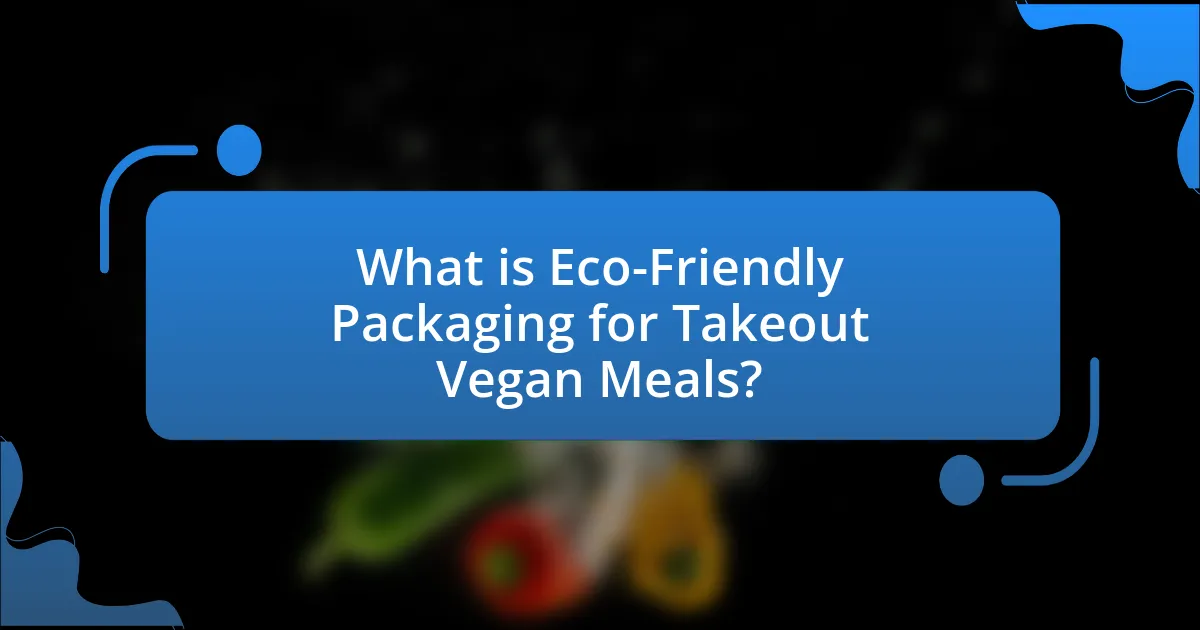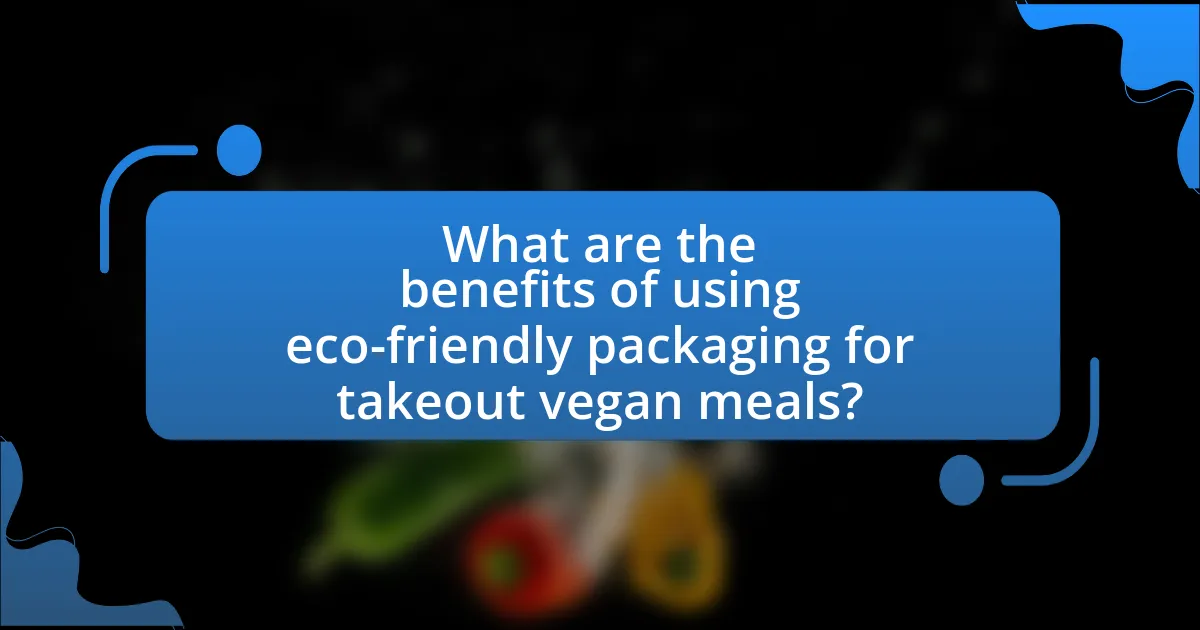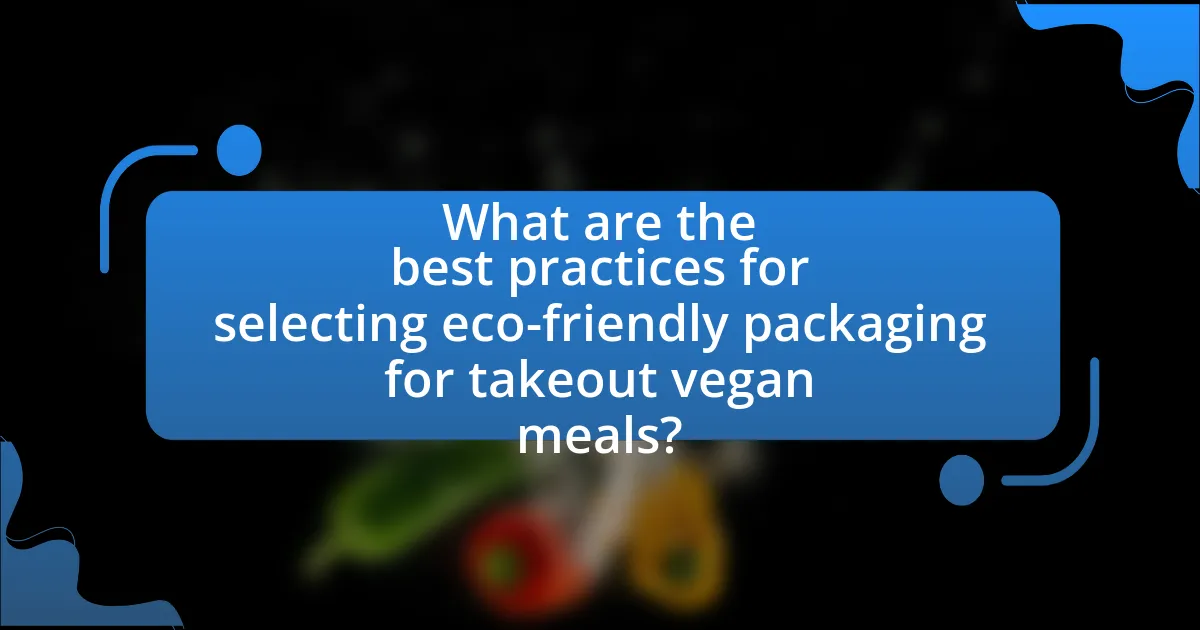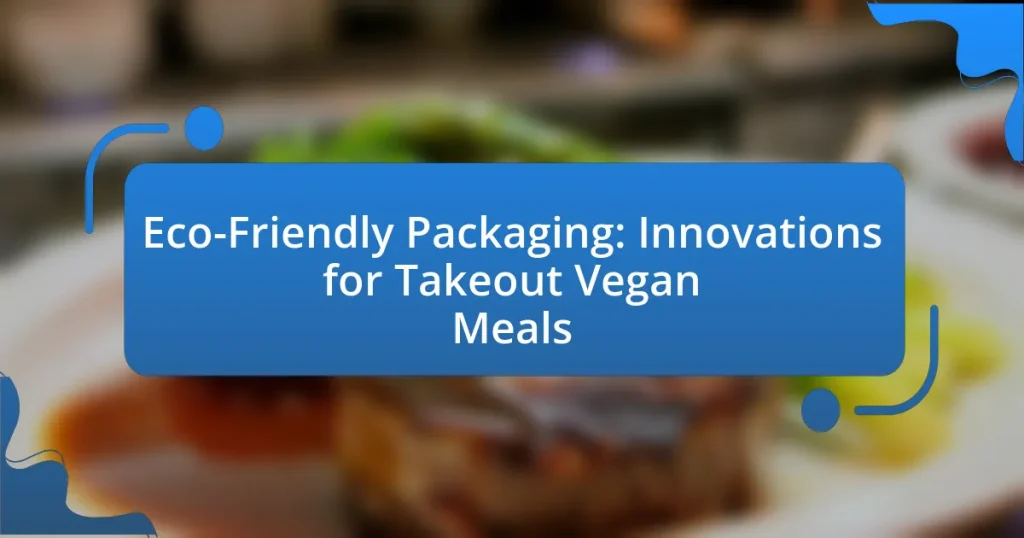Eco-friendly packaging for takeout vegan meals encompasses sustainable materials and designs aimed at minimizing environmental impact while effectively containing food. This article explores the differences between eco-friendly and traditional packaging, highlighting materials such as biodegradable plastics, recycled paper, and plant-based options. It discusses the environmental benefits of using sustainable packaging, including reduced waste and lower carbon emissions, and examines the alignment of eco-friendly practices with vegan principles. Additionally, the article addresses the challenges restaurants face in adopting these solutions, the latest innovations in packaging technology, and best practices for selecting and implementing eco-friendly options in the food service industry.

What is Eco-Friendly Packaging for Takeout Vegan Meals?
Eco-friendly packaging for takeout vegan meals refers to sustainable materials and designs that minimize environmental impact while effectively containing food. This type of packaging often includes biodegradable, compostable, or recyclable materials such as plant-based plastics, recycled paper, and cardboard. According to a study by the Ellen MacArthur Foundation, transitioning to biodegradable packaging can significantly reduce plastic waste, which is crucial given that approximately 300 million tons of plastic are produced annually, much of which ends up in landfills and oceans. Eco-friendly packaging not only supports vegan meal delivery but also aligns with the growing consumer demand for sustainable practices in the food industry.
How does eco-friendly packaging differ from traditional packaging?
Eco-friendly packaging differs from traditional packaging primarily in its materials and environmental impact. Eco-friendly packaging is made from sustainable, biodegradable, or recyclable materials, such as plant-based plastics or recycled paper, which reduce waste and pollution. In contrast, traditional packaging often relies on single-use plastics and non-biodegradable materials, contributing significantly to landfill waste and environmental degradation. According to a study by the Ellen MacArthur Foundation, approximately 79% of plastic waste ends up in landfills or the environment, highlighting the urgent need for sustainable alternatives.
What materials are commonly used in eco-friendly packaging?
Common materials used in eco-friendly packaging include biodegradable plastics, recycled paper, cardboard, and plant-based materials such as cornstarch and sugarcane. Biodegradable plastics break down more quickly than traditional plastics, reducing environmental impact. Recycled paper and cardboard are sourced from post-consumer waste, minimizing the need for virgin materials and lowering carbon emissions. Plant-based materials, like cornstarch and sugarcane, are renewable resources that decompose naturally, further supporting sustainability efforts. These materials collectively contribute to reducing waste and promoting a circular economy in packaging.
How do these materials impact the environment?
Eco-friendly packaging materials significantly reduce environmental impact by minimizing waste and pollution. These materials, such as biodegradable plastics and recycled paper, decompose more easily than traditional plastics, leading to less landfill accumulation and lower greenhouse gas emissions. For instance, a study published in the journal “Environmental Science & Technology” found that biodegradable materials can reduce carbon emissions by up to 50% compared to conventional plastics. Additionally, using recycled materials conserves natural resources and energy, further decreasing the ecological footprint associated with packaging production.
Why is eco-friendly packaging important for vegan meals?
Eco-friendly packaging is important for vegan meals because it aligns with the ethical and environmental values of the vegan lifestyle. Veganism emphasizes reducing harm to animals and minimizing environmental impact, and using sustainable packaging materials helps to further these goals. For instance, traditional packaging often contributes to plastic pollution and greenhouse gas emissions, whereas eco-friendly options, such as biodegradable or compostable materials, reduce waste and promote a circular economy. Research indicates that approximately 300 million tons of plastic are produced annually, with a significant portion ending up in oceans and landfills, harming wildlife and ecosystems. Therefore, adopting eco-friendly packaging for vegan meals not only supports the principles of veganism but also contributes to broader environmental sustainability efforts.
What role does packaging play in the sustainability of vegan meals?
Packaging plays a crucial role in the sustainability of vegan meals by influencing waste reduction and resource conservation. Sustainable packaging materials, such as biodegradable or compostable options, minimize environmental impact compared to traditional plastics, which contribute to pollution and landfill waste. For instance, a study published in the journal “Sustainability” highlights that using compostable packaging can reduce greenhouse gas emissions by up to 50% compared to conventional packaging. Additionally, effective packaging design can enhance food preservation, reducing spoilage and food waste, which is vital in the context of vegan meals that often rely on fresh ingredients. Thus, the choice of packaging directly affects the overall sustainability of vegan meal offerings.
How does eco-friendly packaging align with vegan principles?
Eco-friendly packaging aligns with vegan principles by minimizing environmental harm and avoiding animal-derived materials. Veganism emphasizes reducing harm to animals and the planet, and eco-friendly packaging often utilizes biodegradable, compostable, or recyclable materials that do not contribute to pollution or waste. For instance, materials like plant-based plastics or recycled paper are commonly used in eco-friendly packaging, which supports the vegan ethos of sustainability and ethical consumption. This alignment is further reinforced by the growing awareness of the environmental impact of traditional packaging, which often involves petroleum-based products and contributes to habitat destruction and climate change, both of which are contrary to vegan values.
What innovations are emerging in eco-friendly packaging for takeout vegan meals?
Innovations in eco-friendly packaging for takeout vegan meals include the development of biodegradable materials, such as plant-based plastics made from cornstarch and sugarcane, which decompose more efficiently than traditional plastics. Additionally, companies are increasingly using compostable containers that break down into organic matter, reducing landfill waste. Recent advancements also feature edible packaging made from seaweed and rice paper, which not only minimizes waste but also adds nutritional value. Furthermore, reusable packaging systems are gaining traction, allowing customers to return containers for cleaning and reuse, thereby promoting sustainability. These innovations are supported by research indicating that the global biodegradable packaging market is expected to reach $18.3 billion by 2024, reflecting a growing demand for sustainable solutions in the food industry.
What are the latest trends in biodegradable packaging solutions?
The latest trends in biodegradable packaging solutions include the use of plant-based materials, such as polylactic acid (PLA) and mushroom-based packaging, which are gaining popularity due to their compostability and reduced environmental impact. Additionally, innovations in seaweed and agricultural waste-based packaging are emerging, providing sustainable alternatives that decompose naturally. According to a report by Smithers Pira, the global biodegradable packaging market is expected to reach $6.5 billion by 2024, driven by increasing consumer demand for eco-friendly products and stricter regulations on plastic waste.
How are companies integrating technology into eco-friendly packaging?
Companies are integrating technology into eco-friendly packaging by utilizing biodegradable materials, smart sensors, and digital printing techniques. For instance, many companies are adopting bioplastics made from renewable resources, which decompose more quickly than traditional plastics, thereby reducing environmental impact. Additionally, smart sensors are being embedded in packaging to monitor freshness and reduce food waste, enhancing sustainability. Digital printing allows for customized packaging solutions that minimize ink waste and enable the use of eco-friendly inks. These technological advancements not only improve the sustainability of packaging but also align with consumer demand for environmentally responsible products.
How can restaurants implement eco-friendly packaging solutions?
Restaurants can implement eco-friendly packaging solutions by utilizing biodegradable materials, such as plant-based plastics and recycled paper products. These materials decompose more quickly than traditional plastics, reducing landfill waste. For instance, a study by the Ellen MacArthur Foundation highlights that switching to biodegradable packaging can significantly decrease environmental impact, as these materials can break down in composting facilities within months. Additionally, restaurants can source packaging from suppliers who prioritize sustainable practices, ensuring that their entire supply chain aligns with eco-friendly goals. By adopting these strategies, restaurants not only contribute to environmental sustainability but also appeal to a growing consumer base that values eco-conscious practices.
What challenges do restaurants face when switching to eco-friendly packaging?
Restaurants face several challenges when switching to eco-friendly packaging, primarily related to cost, supply chain logistics, and consumer acceptance. The transition often involves higher initial costs for sustainable materials compared to traditional packaging, which can strain budgets, especially for small businesses. Additionally, sourcing reliable suppliers for eco-friendly options can complicate logistics, as not all suppliers offer sustainable alternatives, leading to potential disruptions in the supply chain. Furthermore, consumer acceptance can be a hurdle; some customers may be resistant to changes in packaging aesthetics or functionality, impacting their overall dining experience. These challenges highlight the complexities restaurants encounter in adopting eco-friendly packaging solutions.

What are the benefits of using eco-friendly packaging for takeout vegan meals?
Using eco-friendly packaging for takeout vegan meals significantly reduces environmental impact by minimizing waste and pollution. This type of packaging is often biodegradable or recyclable, which helps decrease landfill contributions and lowers carbon emissions associated with traditional plastic packaging. According to a study by the Ellen MacArthur Foundation, transitioning to biodegradable materials can reduce plastic pollution by up to 80%. Additionally, eco-friendly packaging aligns with the values of vegan consumers who prioritize sustainability, enhancing brand loyalty and customer satisfaction.
How does eco-friendly packaging enhance customer experience?
Eco-friendly packaging enhances customer experience by aligning with consumer values for sustainability and environmental responsibility. Research indicates that 72% of consumers are more likely to purchase products with eco-friendly packaging, as it reflects their commitment to reducing environmental impact. Additionally, eco-friendly packaging often features innovative designs that improve usability and convenience, such as easy-to-open seals and stackable containers, which further enhance the overall experience. This combination of ethical alignment and practical benefits leads to increased customer satisfaction and loyalty.
What feedback do customers provide regarding eco-friendly packaging?
Customers generally provide positive feedback regarding eco-friendly packaging, appreciating its sustainability and reduced environmental impact. Many customers express satisfaction with the use of biodegradable materials, noting that it aligns with their values of environmental responsibility. Research indicates that 73% of consumers are willing to pay more for sustainable packaging, highlighting a strong preference for eco-friendly options. Additionally, customers often comment on the aesthetic appeal of eco-friendly packaging, which they find visually pleasing and innovative.
How does packaging influence customer purchasing decisions?
Packaging significantly influences customer purchasing decisions by affecting perceptions of quality, sustainability, and convenience. Research indicates that visually appealing and eco-friendly packaging can enhance a product’s attractiveness, leading to increased sales. For instance, a study published in the Journal of Consumer Research found that consumers are willing to pay up to 20% more for products with sustainable packaging, highlighting the importance of eco-friendly materials in influencing buying behavior. Additionally, packaging that clearly communicates the product’s benefits, such as being vegan or environmentally friendly, can further sway consumer choices, as shoppers increasingly prioritize sustainability in their purchasing decisions.
What environmental benefits are associated with eco-friendly packaging?
Eco-friendly packaging significantly reduces environmental impact by minimizing waste and pollution. This type of packaging is often made from biodegradable or recyclable materials, which helps decrease landfill contributions and lowers greenhouse gas emissions. For instance, a study by the Ellen MacArthur Foundation found that transitioning to biodegradable packaging could reduce plastic waste in oceans by up to 80% by 2040. Additionally, eco-friendly packaging typically requires less energy to produce compared to traditional packaging, further contributing to lower carbon footprints.
How does eco-friendly packaging reduce waste?
Eco-friendly packaging reduces waste by utilizing biodegradable or recyclable materials that decompose naturally or can be repurposed, thereby minimizing landfill contributions. Traditional packaging often consists of plastics that persist in the environment for hundreds of years, whereas eco-friendly alternatives, such as those made from plant-based materials, can break down within months. For instance, a study by the Ellen MacArthur Foundation highlights that switching to biodegradable packaging can reduce plastic waste by up to 30% in certain sectors. This shift not only lessens the volume of waste generated but also promotes a circular economy where materials are reused, further decreasing the overall environmental impact.
What impact does it have on carbon footprint?
Eco-friendly packaging significantly reduces the carbon footprint associated with takeout vegan meals. Traditional packaging materials, such as plastic and Styrofoam, contribute to greenhouse gas emissions during production and disposal. In contrast, eco-friendly options like biodegradable, compostable, or recycled materials often require less energy to produce and can decompose naturally, minimizing landfill waste. For instance, a study by the Ellen MacArthur Foundation found that switching to biodegradable packaging could reduce carbon emissions by up to 70% compared to conventional plastic packaging. This shift not only lowers the overall carbon footprint but also promotes sustainable practices within the food industry.
How does eco-friendly packaging contribute to brand image?
Eco-friendly packaging enhances brand image by demonstrating a commitment to sustainability and environmental responsibility. Brands that utilize eco-friendly packaging often attract environmentally conscious consumers, which can lead to increased customer loyalty and positive brand perception. Research indicates that 72% of consumers are willing to pay more for products with sustainable packaging, highlighting the direct correlation between eco-friendly practices and consumer purchasing behavior. This alignment with consumer values not only differentiates brands in a competitive market but also fosters a positive reputation, ultimately contributing to long-term brand success.
What are the marketing advantages of using sustainable packaging?
Sustainable packaging offers significant marketing advantages, including enhanced brand image and increased consumer loyalty. Brands that utilize eco-friendly packaging can differentiate themselves in a crowded market, appealing to environmentally conscious consumers who prioritize sustainability. Research indicates that 66% of global consumers are willing to pay more for sustainable brands, demonstrating a clear market demand for eco-friendly practices. Additionally, sustainable packaging can lead to positive word-of-mouth and social media engagement, as consumers are more likely to share their experiences with brands that align with their values. This alignment not only fosters customer loyalty but also attracts new customers who are increasingly seeking out sustainable options.
How can eco-friendly packaging attract a loyal customer base?
Eco-friendly packaging can attract a loyal customer base by aligning with consumers’ growing environmental values and preferences. Research indicates that 72% of consumers are willing to pay more for sustainable packaging, demonstrating a clear market demand for eco-friendly options. Additionally, brands that adopt sustainable practices often enhance their reputation, leading to increased customer trust and loyalty. For instance, companies like Unilever have reported that their sustainable brands grow faster than their traditional counterparts, reinforcing the idea that eco-friendly packaging not only meets consumer expectations but also drives brand loyalty.

What are the best practices for selecting eco-friendly packaging for takeout vegan meals?
The best practices for selecting eco-friendly packaging for takeout vegan meals include choosing materials that are biodegradable, compostable, or recyclable. Biodegradable materials, such as plant-based plastics or paper, break down naturally and reduce landfill waste. Compostable packaging, like those made from cornstarch or sugarcane, can decompose in industrial composting facilities, returning nutrients to the soil. Recyclable options, such as certain types of cardboard or glass, can be processed and reused, minimizing resource consumption.
Additionally, it is crucial to assess the life cycle of the packaging materials, considering their production, transportation, and disposal impacts. For instance, materials sourced locally can reduce carbon footprints associated with transportation. According to a study by the Ellen MacArthur Foundation, switching to biodegradable and compostable packaging can significantly decrease environmental pollution and resource depletion.
Furthermore, selecting packaging that maintains food quality and safety is essential, as it ensures that vegan meals remain fresh and appealing to consumers. Using materials that are free from harmful chemicals, such as BPA, is also a best practice to ensure the health of both consumers and the environment.
How can restaurants assess the sustainability of packaging options?
Restaurants can assess the sustainability of packaging options by evaluating materials based on their environmental impact, recyclability, and sourcing practices. This involves analyzing whether the packaging is made from renewable resources, biodegradable, or compostable, which contributes to reduced landfill waste. For instance, a study by the Ellen MacArthur Foundation highlights that packaging made from plant-based materials can significantly lower carbon emissions compared to traditional plastics. Additionally, restaurants can implement life cycle assessments (LCAs) to measure the environmental effects of packaging throughout its entire life cycle, from production to disposal. By prioritizing suppliers who adhere to sustainable practices, such as using recycled content or minimizing packaging waste, restaurants can further enhance their sustainability efforts.
What certifications should restaurants look for in eco-friendly packaging?
Restaurants should look for certifications such as FSC (Forest Stewardship Council), BPI (Biodegradable Products Institute), and ASTM D6400 for eco-friendly packaging. The FSC certification ensures that paper and wood products come from responsibly managed forests, promoting sustainable forestry practices. The BPI certification indicates that packaging is compostable in commercial facilities, which helps reduce landfill waste. ASTM D6400 provides standards for biodegradable plastics, ensuring they break down in industrial composting environments. These certifications collectively support environmental sustainability and align with the growing demand for eco-friendly practices in the food service industry.
How can restaurants balance cost and sustainability in packaging choices?
Restaurants can balance cost and sustainability in packaging choices by investing in biodegradable materials that are competitively priced and by optimizing their supply chain for eco-friendly options. Research indicates that the global biodegradable packaging market is projected to reach $18.3 billion by 2024, demonstrating a growing availability of cost-effective sustainable materials. Additionally, restaurants can reduce costs by purchasing in bulk and collaborating with suppliers who prioritize sustainability, thus lowering overall expenses while enhancing their environmental impact.
What tips can help restaurants successfully transition to eco-friendly packaging?
Restaurants can successfully transition to eco-friendly packaging by conducting thorough research on sustainable materials, such as compostable or biodegradable options, and evaluating their suppliers for eco-friendly practices. Implementing a phased approach allows restaurants to gradually replace traditional packaging with sustainable alternatives, minimizing disruption. Training staff on the importance of eco-friendly practices ensures consistent application and customer engagement. Additionally, communicating the benefits of eco-friendly packaging to customers can enhance brand loyalty and attract environmentally conscious consumers. According to a 2021 survey by the National Restaurant Association, 60% of consumers are more likely to choose restaurants that offer sustainable packaging options, highlighting the market demand for such initiatives.
How can staff training improve the implementation of eco-friendly practices?
Staff training can significantly enhance the implementation of eco-friendly practices by equipping employees with the knowledge and skills necessary to adopt sustainable methods. When staff members are trained on the importance of eco-friendly packaging and practices, they become more aware of their environmental impact and are better prepared to make informed decisions. For instance, a study published in the Journal of Cleaner Production found that organizations that invested in employee training on sustainability saw a 20% increase in the adoption of eco-friendly practices. This training can include information on selecting sustainable materials, reducing waste, and understanding the lifecycle of packaging products, which directly contributes to more effective implementation of eco-friendly initiatives in the context of takeout vegan meals.
What strategies can be used to educate customers about eco-friendly packaging?
To educate customers about eco-friendly packaging, businesses can implement strategies such as informative labeling, interactive workshops, and digital content marketing. Informative labeling on packaging can highlight the environmental benefits and materials used, making it easier for consumers to understand their choices. Interactive workshops can engage customers directly, allowing them to learn about sustainable practices and the impact of packaging waste. Digital content marketing, including social media campaigns and educational blogs, can disseminate information about eco-friendly packaging options and their advantages, reaching a broader audience. These strategies are effective as they provide clear, accessible information that empowers consumers to make informed decisions regarding their packaging choices.
What common pitfalls should restaurants avoid when adopting eco-friendly packaging?
Restaurants should avoid the pitfall of selecting eco-friendly packaging without thoroughly researching its environmental impact. Many materials marketed as sustainable, such as certain bioplastics, may not decompose effectively in landfills or may require specific industrial composting facilities that are not widely available. Additionally, restaurants should not overlook the importance of functionality; packaging that fails to maintain food quality or is not user-friendly can lead to customer dissatisfaction. Lastly, failing to communicate the eco-friendly nature of the packaging to customers can result in missed marketing opportunities and reduced consumer support for sustainable practices.


